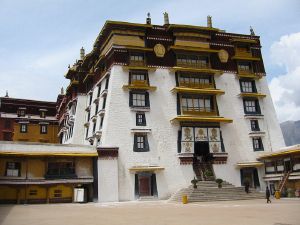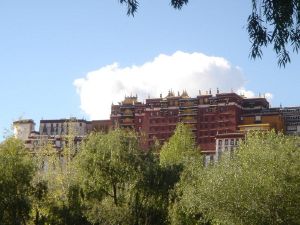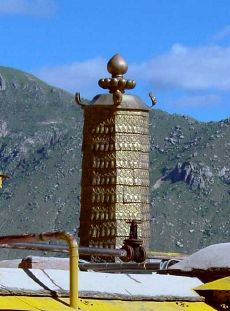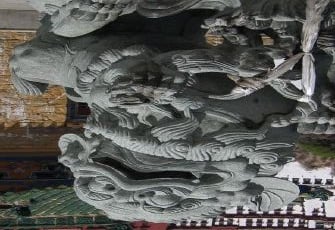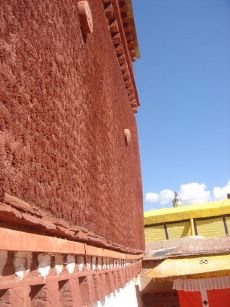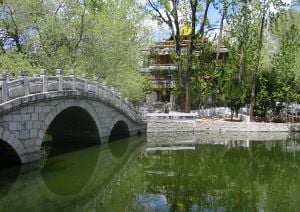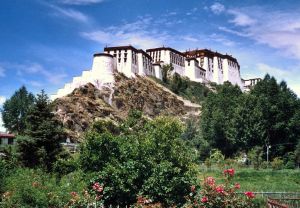Potala Palace
| Historic Ensemble of the Potala Palace, Lhasa* | |
|---|---|
| UNESCO World Heritage Site | |

| |
| State Party | |
| Type | Cultural |
| Criteria | i, iv, vi |
| Reference | 707 |
| Region** | Asia-Pacific |
| Inscription history | |
| Inscription | 1994 (18th Session) |
| Extensions | 2000; 2001 |
| * Name as inscribed on World Heritage List. ** Region as classified by UNESCO. | |
The Potala Palace (Tibetan: པོ་ཏ་ལ།) located in Lhasa, Tibet Autonomous Region, in People's Republic of China. The Potala Palace was the chief residence of the Dalai Lama until the 14th Dalai Lama fled to Dharamsala, India after a failed uprising in 1959. Today the Potala Palace has been forcibly converted into a museum by the Chinese. It was named after Mount Potala, the abode of Chenresig or Avalokitesvara.[1]

Thirteen stories of buildings containing over 1,000 rooms, 10,000 shrines and about 200,000 statues, soar 117 metres (384 ft) on top of Marpo Ri, the "Red Hill", rising more than 300 m (about 1,000 ft) in total above the valley floor.[2] It measures 400 metres east-west and 350 metres north-south, with sloping stone walls averaging 3 m. thick, and 5 m. (more than 16 ft) thick at the base, and with copper poured into the foundations to help proof it against earthquakes.[3]
- "The Potala gives the impression not of having been built by man but have grown there, so perfectly does it fit in with its surroundings. It has the pleasing lack of symmetry of a great tree or mountain, yet this apparent aimlessness is focused, first by the red central block and then by the golden pavilions on the roof, so that the eye is naturally led from the less important to the essential, both visually and spiritually; for in so much as the gilded roofs over the mortal remains of the Dalai Lamas are the dominant figure of the architecture, so is the incarnate spirit of these rulers the very soul of Tibet."[4]
History
The site was used as a meditation retreat by King Songtsen Gampo, who in 637 built the first palace there in order to greet his bride Princess Wen Cheng of the Tang Dynasty of China. The construction of the present palace began in 1645 under the fifth Dalai Lama, Lozang Gyatso. In 1648, the Potrang Karpo (White Palace) was completed, and the Potala was used as a winter palace by the Dalai Lama from that time. The Potrang Marpo (Red Palace) was added between 1690 and 1694.[5]
- "The new palace got its name from a hill on Cape Comorin at the southern tip of India—a rocky point sacred to the God of Mercy, whom the Indians call Avalokitesvara and the Tibetans worship as Chenrezi. The Tibetans themselves rarely speak of the sacred place as the "Potala," but rather as "Peak Potala" (Tse Potala), or usually as "the Peak."[6]
It is a popular tourist attraction, a UNESCO World Heritage Site, and was named by the American television show Good Morning America and newspaper USA Today as one of the "New Seven Wonders".[7]
Its beauty and significance
- "Certainly the Potala is one of the most astonishing buildings in the world, whether it is seen from afar perched on the summit of the eminence which rises from the level plain of Lhasa, with the sun striking flame from the golden pavilions of its roof, or whether, riding out before dawn, you see the moonlight thrown back with unearthly brilliance from the whitewashed wall of the immense southern face. All the supremely great works of art, in literature, painting, or architecture, have an indefinable quality of magic which is born from circumstances usually beyond the artist's control; so, in common with the few unquestionably perfect buildings of the world, the Potala has some transcendent quality derived neither from the inspired skill of some master builder or craftsmen, nor from its historical associations, nor from the fact that it is the cynosure of innumerable religious devotees. That it does possess this divine excellence cannot be doubted."[8]
Built at an altitude of 3,700 m (12,100 ft), on the side of Marpo Ri ('Red Mountain') in the center of Lhasa Valley,[9] the Potala Palace, with its vast inward-sloping walls broken only in the upper parts by straight rows of many windows, and its flat roofs at various levels, is not unlike a fortress in appearance. At the south base of the rock is a large space enclosed by walls and gates, with great porticos on the inner side. A series of tolerably easy staircases, broken by intervals of gentle ascent, leads to the summit of the rock. The whole width of this is occupied by the palace.
The central part of this group of buildings rises in a vast quadrangular mass above its satellites to a great height, terminating in gilt canopies similar to those on the Jokhang. This central member of Potala is called the "red palace" from its crimson colour, which distinguishes it from the rest. It contains the principal halls and chapels and shrines of past Dalai Lamas. There is in these much rich decorative painting, with jewelled work, carving and other ornament.
The Potala Palace was inscribed to the UNESCO World Heritage List in 1994. In 2000 and 2001, Jokhang Temple and Norbulingka were added to the list as extensions to the sites.
In addition, the Chinese Putuo Zongcheng Temple, built between 1767 and 1771, was modeled after the Potala Palace.
White Palace
The White Palace is the part of the Potala Palace that makes up the living quarters of the Dalai Lama. The first White Palace was built during the lifetime of the fifth Dalai Lama in the 1650s then was extended to its size today by the thirteenth Dalai Lama in the early twentieth century. The palace was for secular uses and contained the living quarters, offices, the seminary and the printing house. A central, yellow-painted courtyard known as a Deyangshar separates the living quarters of the Lama and his monks with the Red Palace, the other side of the sacred Potala, which is completely devoted to religious study and prayer. It contains the sacred gold stupas—the tombs of eight Dalai Lamas—the monks' assembly hall, numerous chapels and shrines, and libraries for the important Buddhist scriptures, the Kangyur in 108 volumes and the Tengyur with 225. The yellow building at the side of the White Palace in the courtyard between the main palaces houses giant banners embroidered with holy symbols which hung across the south face of the Potala during New Year festivals.
Red Palace
The Red Palace is part of the Potala palace that is completely devoted to religious study and Buddhist prayer. It consists of a complicated layout of many different halls, chapels and libraries on many different levels with a complex array of smaller galleries and winding passages:
The Great West Hall
The main central hall of the Red Palace is the Great West Hall which consists of four great chapels that proclaim the glory and power of the builder of the Potala, the Fifth Dalai Lama. The hall is noted for its fine murals reminiscent of Persian miniatures, depicting events in the fifth Dalai Lama's life. The famous scene of his visit to Emperor Shun Zhi in Beijing is located on the east wall outside the entrance. Special cloth from Bhutan wraps the Hall's numerous columns and pillars.
The Saint's Chapel
On the north side of this hall in the Red Palace is the holiest shrine of the Potala. A large blue and gold inscription over the door was written by the 19th century Tongzhi Emperor of China. proclaiming Buddhism a Blessed Field of Wonderful Fruit. This chapel like the Dharma cave below it dates from the seventh century. It contains a small ancient jewel encrusted statue of Avalokiteshvara and two of his attendants. On the floor below, a low, dark passage leads into the Dharma Cave where Songsten Gampo is believed to have studied Buddhism. In the holy cave are images of Songsten Gampo, his wives, his chief minister and Sambhota, the scholar who developed Tibetan writing in the company of his many divinities.
The North Chapel
The North Chapel centres on a crowned Sakyamuni Buddha on the left and the Fifth Dalai Lama on the right seated on magnificent gold thrones. Their equal height and shared aura implies equal status. On the far left of the chapel is the gold stupa tomb of the Eleventh Dalai Lama who died as a child, with rows of benign Medicine Buddhas who were the heavenly healers. On the right of the chapel are Avalokiteshvara and his historical incarnations including Songsten Gampo and the first four Dalai Lamas. Scriptures covered in silk between wooden covers form a specialized library in a room branching off it.
The South Chapel
The South Chapel centres on Padmasambhava, the 8th century Indian magician and saint. His consort Yeshe Tsogyal, a gift from the King is by his left knee and his other wife from his native land of Swat is by his right. On his left, eight of his holy manifestations meditate with an inturned gaze. On his right, eight wrathful manifestations wield instruments of magic powers to subdue the demons of the Bön faith.
The East Chapel
The East chapel is dedicated to Tsong Khapa, founder of the Gelug tradition. His central figure is surrounded by lamas from Sakya Monastery who had briefly ruled Tibet and formed their own tradition until converted by Tsong Khapa. Other statues are displayed made of various different materials and display noble expressions.
The West Chapel
This is the chapel that contains the five golden stupas. The enormous central stupa, 14.85 metres (49 ft) high, contains the mummified body of the Fifth Dalai Lama. This stupa is built of sandalwood and is remarkably coated in 3,727 kg (8,200 lb) of solid gold and studded with 18,680 pearls and semi-precious jewels.<ref[1]</ref> On the left is the funeral stupa for the Twelfth Dalai Lama and on the right that of the Tenth Dalai Lama. The nearby stupa for the 13th Dalai Lama is 22 metres (72 ft) high. The stupas on both ends contain important scriptures.[10]
The First Gallery
The first gallery is on the floor above the West chapel and has a number of large windows that give light and ventilation to the Great West Hall and its chapels below. Between the windows, superb murals show the Potala's construction is fine detail.
The Second Gallery
The Second Gallery gives access to the central pavilion which is used for visitors to the palace for refreshments and to buy souvenirs.
The Third Gallery
The Third Gallery besides fine murals has a number of dark rooms branching off it containing enormous collections of bronze statues and miniature figures made of copper and gold worth a fortune. The chanting hall of the Seventh Dalai Lama is on the south side and on the east an entrance connects the section to the Saints chapel and the Deyangshar between the two palaces.
The Tomb of the Thirteenth Dalai Lama
The tomb of the 13th Dalai Lama is located west of the Great West Hall and it can only be reached from an upper floor and with the company of a monk or a guide of the Potala. Built in 1933, the giant stupa contains priceless jewels and one ton of solid gold. It is 14 metres (46 feet) high. Devotional offerings include elephant tusks from India, porcelain lions and vases and a pagoda made from over 200,000 pearls. Elaborate murals in traditional Tibetan styles depict many events of the life of the Thirteenth Dalai Lama during the early 20th century.
See also
- Norbulingka, the Dalai Lama's former summer palace
- Jokhang Temple Monastery
- Dhvaja
- Kundun, a 1997 film about the Dalai Lama, chiefly set inside the palace
- Seven Years in Tibet
Footnotes
- ↑ Stein, R. A. Tibetan Civilization (1962). Translated into English with minor revisions by the author. 1st English edition by Faber & Faber, London (1972). Reprint: Stanford University Press (1972), p. 84
- ↑ Buckley, Michael and Strausss, Robert. Tibet: a travel survival kit, p. 131. Lonely Planet. South Yarra, Vic., Australia. ISBN 0-908086-88-1.
- ↑ Booz, Elisabeth B. (1986). Tibet, pp. 62-63. Passport Books, Hong Kong.
- ↑ Chapman, F. Spencer. (1940) Lhasa: The Holy City, pp. 173-174. Readers Union Ltd., London.
- ↑ Stein, R. A. Tibetan Civilization (1962). Translated into English with minor revisions by the author. 1st English edition by Faber & Faber, London (1972). Reprint: Stanford University Press (1972), p. 84.
- ↑ Lowell Thomas, Jr. (1951). Out of this World: Across the Himalayas to Tibet. Reprint: 1952, p. 181. Macdonald & Co., London
- ↑ ABC Good Morning America "7 New Wonders" Page
- ↑ Chapman, F. Spencer. (1940) Lhasa: The Holy City, pp. 171-172. Readers Union Ltd., London.
- ↑ Stein, R. A. Tibetan Civilization (1962). Translated into English with minor revisions by the author. 1st English edition by Faber & Faber, London (1972). Reprint: Stanford University Press (1972), p. 206
- ↑ Buckley, Michael and Strausss, Robert. Tibet: a travel survival kit, p. 131. Lonely Planet. South Yarra, Vic., Australia. ISBN 0-908086-88-1.
ReferencesISBN links support NWE through referral fees
- "Reading the Potala." Peter Bishop. In: Sacred Spaces and Powerful Places In Tibetan Culture: A Collection of Essays. (1999) Edited by Toni Huber, pp. 367-388. The Library of Tibetan Works and Archives, Dharamsala, H.P., India. ISBN 81-86470-22-0.
- Das, Sarat Chandra. Lhasa and Central Tibet. (1902). Edited by W. W. Rockhill. Reprint: Mehra Offset Press, Delhi (1988), pp. 145-146; 166-169; 262-263 and illustration opposite p. 154.
- This article incorporates text from the Encyclopædia Britannica Eleventh Edition, a publication now in the public domain.
External links
- Travel guide to Potala Palace from Wikitravel
- Potala Palace (Unesco)
- Potala (Tibetan and Himalayan Digital Library)
- - Research work on possible relation with Potala, Malaya Mountains and South India
- - Information on Sabarimala and Potala
- - Research work on Buddhism in India
- The Potala (China Tibet Information Center)
- satellite view (WikiMapia)
| |||||||
| |||||||||
Credits
New World Encyclopedia writers and editors rewrote and completed the Wikipedia article in accordance with New World Encyclopedia standards. This article abides by terms of the Creative Commons CC-by-sa 3.0 License (CC-by-sa), which may be used and disseminated with proper attribution. Credit is due under the terms of this license that can reference both the New World Encyclopedia contributors and the selfless volunteer contributors of the Wikimedia Foundation. To cite this article click here for a list of acceptable citing formats.The history of earlier contributions by wikipedians is accessible to researchers here:
The history of this article since it was imported to New World Encyclopedia:
Note: Some restrictions may apply to use of individual images which are separately licensed.
